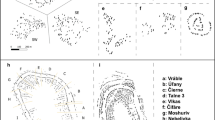Abstract
Lengths of all caves in a region have been observed previously to be distributed hyperbolically, like self-similar geomorphic phenomena identified by Mandelbrot as exhibiting fractal geometry. Proper cave lengths exhibit a fractal dimension of about 1.4. These concepts are extended to other self-similar geometric properties of caves with the following consequences.
Lengths of a cave is defined as the sum of sizes of passage-filling, linked modular elements larger than the cave-defining modulus. If total length of all caves in a region is a self-similar fractal, it has a fractal dimension between 2 and 3; and the total number of linked modular elements in a region is a self-similar fractal of the same dimension. Cave volume in any modular element size range may be calculated from the distribution.
The expected conditional distribution of modular element sizes in a cave, given length and modulus, also is distributed hyperbolically. Data from Little Brush Creek Cave (Utah) agree and yield a fractal dimension of about 2.8 (like the Menger Sponge). The expected number of modular elements in a cave equals approximately the 0.9 power of length of the cave divided by modulus. This result yields an intriguing “parlor trick.” An algorithm for estimating modular element sizes from survey data provides a means for further analysis of cave surveys.
Similar content being viewed by others
References
Blumenthal, L. M. and Menger, K., 1970, Studies in geometry: W. H. Freeman, San Francisco, p. 502.
Chabert, C. and Watson, R. A., 1981, Mapping and measuring caves—a conceptual analysis: Bull. Nat. Speleo. Soc., v. 43, p. 3–11.
Curl, R. L., 1960, Stochastic models of cavern development: Bull. Nat. Speleo. Soc., v. 22, p. 66–76.
Curl, R. L., 1964, On the definition of a cave: Bull. Nat. Speleo. Soc., v. 26, p. 1–6.
Curl, R. L., 1966, Caves as a measure of karst: J. Geol., v. 74, no. 5, part 2, p. 798–830.
Dubljanski, V. N., Iljuhin, V. V., and Lobanov, J. E., 1980, Some problems relating to the morphometry of karst caves: Nase Jame, v. 21, p. 75–84.
Fréchet, M., 1941, Sur la loi de répartition de certaines grandeurs géographiques: J. Soc. Stat. Paris, v. 82, p. 114–122.
Halleck, J. B., 1984, personal communication.
Korčak, J., 1940, Deux types fondamentaux de distribution statistique: Bull. Inst. Int. Stat., v. 30, p. 295–299.
Mandelbrot, B. B., 1983, The fractal geometry of nature: W. H. Freeman, San Francisco, 468 p.
Morrison, D. A. and Clanton, U. S., 1979, Properties of microcraters and cosmic dust of less than 1000 A dimensions: Proceedings of the 10th Lunar Planetary Science Conference, p. 1649–1663.
Richardson, L. F., 1961, The problem of contiguity: An appendix of statistics of deadly quarrels: Gen. Sys. Yearbook, v. 6, p. 139–187.
Šušteršič, F., 1978, What is speleometry?: Nase Jame, v. 20, p. 21–29.
Šušteršič, F., 1980, Some basic dimensions of the speleogenes: Nase Jame, v. 21, p. 61–73.
Author information
Authors and Affiliations
Rights and permissions
About this article
Cite this article
Curl, R.L. Fractal dimensions and geometries of caves. Math Geol 18, 765–783 (1986). https://doi.org/10.1007/BF00899743
Received:
Accepted:
Issue Date:
DOI: https://doi.org/10.1007/BF00899743




